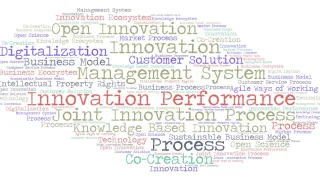Innovation is a process that creates new and unique value for a customer on the market place. In circular economy, marketplace must often be built alongside solutions and business models. Systemic change is therefore needed and can best be achieved by collaborative and innovative ecosystems. We want the development of Finnish innovation management to be one of the best in the world, building and utilising new types of digital innovation platforms.

You could generalize and say that any organisation can create value for the customer but very few can produce new and unique value in a sustainable manner, which is the absolute heart of innovation.
Value creation is always linked to the customer's operating environment: a marketplace does not always exist in the circular economy but must be built piece by piece and often locally. Scaling solutions also requires localization. Therefore, circular economy solutions and business models typically require extensive systemic change and pose specific challenges to innovation activities.
Point 1. Building circular economy requires ecosystems
Systemic approach, cooperation and openness are emphasized in the creation of innovations when the operating environment is being built or changed. These values are best implemented in close interaction between companies, research institutes, the public sector, consumers and potentially other actors, in other words, in ecosystems. Ecosystems are close, dynamic and often self-directed networks in which openness, interaction and interdependence are stronger than in conventional networks and clusters.
Co-creation is a key competence for participants in different ecosystems but each ecosystem sets different requirements for cooperation. Competence ecosystems aim at open sharing of expertise which can be done, among other things, by publishing research results and organizing seminars or similar events. On the other hand, operations in a business ecosystem are based on customer-owned but functionally shared business processes, whose operations and efficiency are monitored and controlled actively from the perspective of both customer value and shared business.
Innovation ecosystems differ significantly from competence and business ecosystems. Their challenging task is to create completely new and unique customer value (new products, solutions and services) and to do it together while sharing the value of business.
Point 2. Innovation is a joint and communal process of an innovation ecosystem
Systemic change from a traditional idea-driven innovation process must move towards a needs-based or challenge-driven process that is highly competence-intensive and communal. New solutions or services that are interconnected must be designed to work together effectively. It is also necessary to enable the emergence of new business ecosystems that are already effective from the outset.
At its best, a competence ecosystem can rapidly grow into an innovation ecosystem that develops shared solutions and further into a new business ecosystem. The new business ecosystems have a key to saving the Finnish business life and well-being, which has already been clearly identified in Finland.
The functioning of co-creation in an innovation ecosystem has a key impact on what kind of innovations are generated in it and, in particular, how quickly they are created. Without exception, cooperation must also be led. The joint innovation process is the key tool and facilitator of the work. At best, it enables rapid progress to commercial solutions without a pilot phase.
Point 3. Innovation capacity is the key feature of the ecosystem
Innovation capacity is the most important feature of the ecosystem in systemic change. The key elements of innovation capacity are the ability to:
- Recognize future customer needs
- Develop solution concepts that produce new and unique value for the customer
- Implement solution concepts also in practice.
All of these require close, determined and well-managed co-creation and competence management.
Innovation capacity is a rather brutal skill: you can only be excellent or terrible at it, since the absence of any of the above-mentioned skills means that the innovation capacity is zero. However, innovation capacity can be influenced fairly efficiently and quickly by innovation management, provided that the community already has a shared way of thinking and acting: a shared innovation process. Through a shared and efficiently managed innovation process, new solutions can be brought to the market at an ever-accelerating rate - and in terms of business, they will be much stronger and more vital.
Innovation capacity can also be influenced by various physical and digital cooperation platforms, which can rightly be called innovation platforms. Physical innovation platforms that enable quick, small-scale experiments are already a part of the everyday life in Finland. Digital innovation platforms also already enable strategic and multidisciplinary cooperation and solution planning in a virtual environment. If taken a few steps further, they could even take the planned solution implementation directly to the commercial environment.
Digital innovation platforms are perhaps the single most important facilitator of new ecosystem business in Finland, and it is therefore worth continuing to invest in their development. Digital innovation platforms would help us quickly make circular economy or other systemic changes into the sustainable and growing foundation of the Finnish economy that we are now aiming towards in the aftermath of the pandemic. Our resources are small, but with close, efficient and creative cooperation, we can keep our competitiveness at the highest level.





